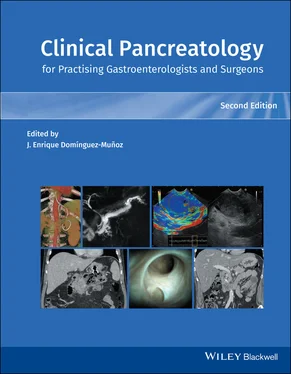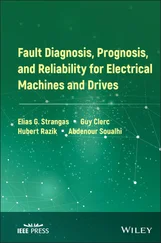These two large studies laid the foundation for hybrid management strategies in a multidisciplinary approach comprising gastroenterologists with therapeutic endoscopy training, interventional radiologists, and surgeons. No particular size fits all, and the combination of multiple strategies may achieve the best outcomes in these oftentimes complex and very ill patients. More recently, there have been several large randomized trials and meta‐analyses to investigate the nuances of the step‐up approach and its efficacy. Hollemans et al. [30] recently reevaluated the patients initially presented in the PANTER trial with regard to their long‐term outcomes and management; 73 of the initial 88 patients were still alive and able to be studied at a mean of 86 months post index admission, with a primary end point of death or major complications as well as long‐term development of exocrine pancreatic insufficiency, endocrine insufficiency, and quality of life and pain scores. From index admission to long‐term follow‐up, there was a significantly higher rate of death or major complications in the open necrosectomy group compared with the surgical step‐up approach group (73% vs. 44%; P = 0.05). Further, those undergoing open necrosectomy were more likely to have exocrine pancreatic insufficiency (56% vs. 29%; P = 0.03) and endocrine insufficiency (64% vs. 40%; P = 0.05), again demonstrating on a long‐term basis the superiority of a surgical step‐up approach compared to open necrosectomy.
Van Brunschot et al. [31] investigated EUS‐guided transluminal drainage with endoscopic necrosectomy versus a surgical step‐up approach in a multicenter randomized superiority trial involving 19 hospitals in the Netherlands. A total of 98 patients were enrolled and randomized, with no significant differences in mortality rates (18% in endoscopy vs. 13% in surgery), nor any significant differences in any other major complication, though there were lower rates of pancreatic fistula formation and length of stay in the endoscopy group. Bang et al. [32] conducted a single‐center randomized trial of 66 patients with confirmed or suspected infected pancreatic necrosis requiring intervention with randomization to minimally invasive surgery (either laparoscopic or VARD) or endoscopic step‐up approach including transluminal drainage with and without necrosectomy with a composite end point of major complications, including new‐onset multiorgan failure, new‐onset systemic dysfunction, enteral or pancreato‐cutaneous fistula, bleeding, perforation, or death. Of the patients undergoing the endoscopic approach, 11.8% reached the composite end point whereas 40.6% of patients undergoing surgical interventions reached the composite end point (RR 0.29, 95% CI 0.11–0.80; P = 0.007). There were no significant differences in mortality among groups but none of the patients undergoing endoscopic approaches developed fistula, while 28.1% of patients undergoing surgery developed fistulas ( P = 0.001), with a significantly higher mean number of complications in the surgical group as well. The mean total cost was also significantly lower in the endoscopic group compared to the surgical group (US$75 830 vs. US$117 492; P = 0.039) [32]. Khan et al. [33] performed a meta‐analysis evaluating the safety of endoscopic drainage versus minimally invasive surgical necrosectomy in the treatment of WON, in which two randomized controlled trials and four observational studies of 641 patients were included, with an overall 8.5% mortality rate in the endoscopic drainage group compared with a 14.2% mortality rate in the minimally invasive surgical necrosectomy group, with a pooled odds ratio (OR) of 0.59 favoring endoscopic drainage (95% CI 0.35–0.98). Further, rates of development of new major organ failure post intervention were 12% in the endoscopic group compared to 54% in the surgical group, with a pooled OR of 0.12 (95% CI 0.06–0.31) favoring endoscopic drainage, a lower overall adverse events rate favoring endoscopic drainage (pooled OR 0.25, 95% CI 0.10–0.67), as well as shorter length of stay in the endoscopic group with a pooled mean difference of –21.07 days (95% CI –36.97 to –5.18 days).
Methods of Endoscopic Necrosectomy and Stent Choice
Since their advent just a few years ago, LAMS have fundamentally altered the endoscopic management approach to both solid and cystic collections. These stents allow continued access with decreased risk of migration, can be easily and safely placed endoscopically, and enable drainage of larger amounts and sizes of tissue and allow direct endoscopic access into the collection for debridement. The endoscopic access options available to the endoscopist include placement of plastic stents or LAMS. Adler et al. [34] in a multicenter (four tertiary care centers across the United States) retrospective study of 80 patients with pancreatic fluid collections drained with LAMS showed that the overall technical success rate was 98.7% with no statistically significant difference in the technical success rate between the inpatient and outpatient groups, although there was a significantly lower number of procedures required for resolution in the inpatient group compared to the outpatient group (2.3 vs. 3.1; P = 0.025), as well as significantly lower adverse event rates in the inpatient versus the outpatient group ( P <0.01). While critically ill patients require inpatient hospitalization and management, this study demonstrates that those who have symptomatic collections who are otherwise stable may be able to be managed as outpatients in an ambulatory setting with close interval follow‐up.
There have been multiple studies examining the use of LAMS or fully covered metal stents versus plastic stents in the management of WON. Abu Dayyeh et al. [35] performed a retrospective study of 94 patients with WON at the Mayo Clinic in which 36 patients underwent double‐pigtail plastic stent placement and 58 patients underwent large‐caliber fully covered self‐expanding metal stent placement. There was no significant difference in the resolution rates between the two groups, and interestingly of the 80% of patients successfully treated with endoscopic approaches alone without the need for percutaneous intervention, nearly half (49%) only required transmural drainage without subsequent necrosectomy. WON was significantly more likely to resolve without the need for endoscopic necrosectomy in the self‐expandable metal stent group compared with the double‐pigtail plastic stent group (60.4% vs. 30.8%; P = 0.01), which remained more likely after adjustment for patient age, size, and location of the necroma (OR 4.5, 95% CI 1.5–15.5). There was a clinically significant higher risk of bleeding requiring endoscopic intervention in the plastic stent group compared to the metal stent group (14% vs. 2%; P = 0.02). The results of LAMS in drainage remain somewhat mixed. Bang et al. [36] recently randomized 60 patients with WON to LAMS ( n = 31) or plastic stent ( n = 29) placement in which there was no significant difference in the total number of procedures performed (LAMS: median 2, range 2–7 vs. plastic: median 3, range 2–7). Unsurprisingly, procedure duration was significantly shorter using LAMS (15 vs. 40 minutes; P <0.001); however, there were significantly higher stent‐related adverse event rates with LAMS (32.3% vs. 6.9%; P = 0.01) and higher cost with LAMS (US$12 155 vs. US$6609; P <0.001).
Importantly, one of the key factors in minimizing stent‐related adverse events was performance of follow‐up imaging and stent removal at three weeks post placement if the WON had resolved. This is especially important for preventing complications from collapse of the collection, with erosion of the posterior wall of the collection against the stent causing bleeding, which can be prevented by close interval imaging with removal of the stent on near collapse of the collection. Mohan et al. [37] performed a systematic review and meta‐analysis examining LAMS and plastic stents in WON in which nine studies of 737 patients with LAMS were compared to six studies of 527 patients with plastic stents. The pooled clinical success rate showed no significant difference between LAMS (88.5%, 95% CI 82.5–92.6) and plastic stents (88.1%, 95% CI 80.5–93.0; P = 0.93). Further, there was no significant difference in the pooled rates of all adverse events (LAMS 11.2%, 95% CI 6.8–17.9 vs. plastic stents 15.9%, 95% CI 8.4–27.8; P = 0.38). The authors concluded that there were equal clinical outcomes and adverse events among both stent types, though significant heterogeneity was present in all included studies and end points.
Читать дальше












